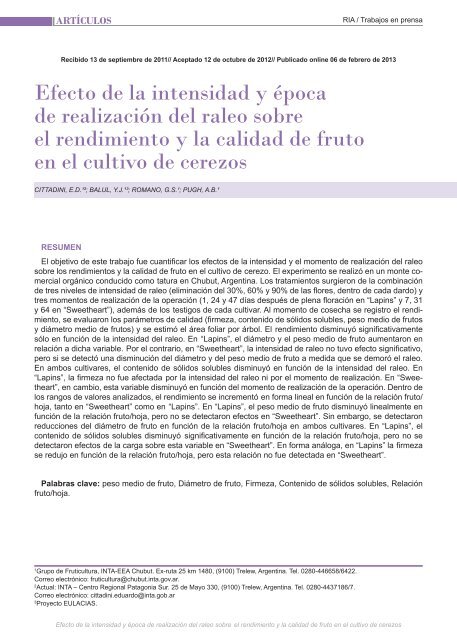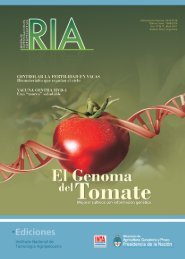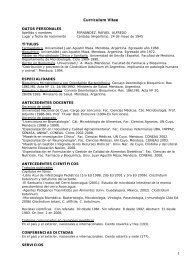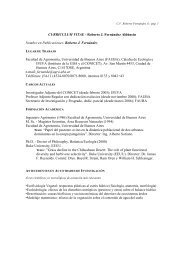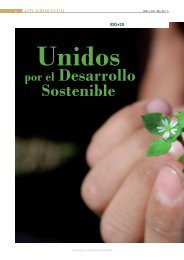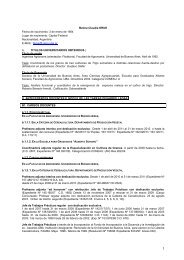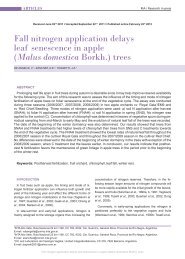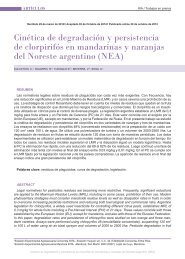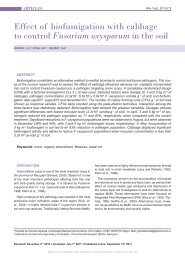Efecto de la intensidad y época de realización del raleo ... - INTA
Efecto de la intensidad y época de realización del raleo ... - INTA
Efecto de la intensidad y época de realización del raleo ... - INTA
Create successful ePaper yourself
Turn your PDF publications into a flip-book with our unique Google optimized e-Paper software.
ARTÍCULOS<br />
RIA / Trabajos en prensa<br />
Recibido 13 <strong>de</strong> septiembre <strong>de</strong> 2011// Aceptado 12 <strong>de</strong> octubre <strong>de</strong> 2012// Publicado online 06 <strong>de</strong> febrero <strong>de</strong> 2013<br />
<strong>Efecto</strong> <strong>de</strong> <strong>la</strong> <strong>intensidad</strong> y época<br />
<strong>de</strong> realización <strong>de</strong>l <strong>raleo</strong> sobre<br />
el rendimiento y <strong>la</strong> calidad <strong>de</strong> fruto<br />
en el cultivo <strong>de</strong> cerezos<br />
CITTADINI, E.D.¹²; BALUL, Y.J.¹³; ROMANO, G.S.¹; PUGH, A.B.¹<br />
RESUMEN<br />
El objetivo <strong>de</strong> este trabajo fue cuantificar los efectos <strong>de</strong> <strong>la</strong> <strong>intensidad</strong> y el momento <strong>de</strong> realización <strong>de</strong>l <strong>raleo</strong><br />
sobre los rendimientos y <strong>la</strong> calidad <strong>de</strong> fruto en el cultivo <strong>de</strong> cerezo. El experimento se realizó en un monte comercial<br />
orgánico conducido como tatura en Chubut, Argentina. Los tratamientos surgieron <strong>de</strong> <strong>la</strong> combinación<br />
<strong>de</strong> tres niveles <strong>de</strong> <strong>intensidad</strong> <strong>de</strong> <strong>raleo</strong> (eliminación <strong>de</strong>l 30%, 60% y 90% <strong>de</strong> <strong>la</strong>s flores, <strong>de</strong>ntro <strong>de</strong> cada dardo) y<br />
tres momentos <strong>de</strong> realización <strong>de</strong> <strong>la</strong> operación (1, 24 y 47 días <strong>de</strong>spués <strong>de</strong> plena floración en “Lapins” y 7, 31<br />
y 64 en “Sweetheart”), a<strong>de</strong>más <strong>de</strong> los testigos <strong>de</strong> cada cultivar. Al momento <strong>de</strong> cosecha se registro el rendimiento,<br />
se evaluaron los parámetros <strong>de</strong> calidad (firmeza, contenido <strong>de</strong> sólidos solubles, peso medio <strong>de</strong> frutos<br />
y diámetro medio <strong>de</strong> frutos) y se estimó el área foliar por árbol. El rendimiento disminuyó significativamente<br />
sólo en función <strong>de</strong> <strong>la</strong> <strong>intensidad</strong> <strong>de</strong>l <strong>raleo</strong>. En “Lapins”, el diámetro y el peso medio <strong>de</strong> fruto aumentaron en<br />
re<strong>la</strong>ción a dicha variable. Por el contrario, en “Sweetheart”, <strong>la</strong> <strong>intensidad</strong> <strong>de</strong> <strong>raleo</strong> no tuvo efecto significativo,<br />
pero si se <strong>de</strong>tectó una disminución <strong>de</strong>l diámetro y <strong>de</strong>l peso medio <strong>de</strong> fruto a medida que se <strong>de</strong>moró el <strong>raleo</strong>.<br />
En ambos cultivares, el contenido <strong>de</strong> sólidos solubles disminuyó en función <strong>de</strong> <strong>la</strong> <strong>intensidad</strong> <strong>de</strong>l <strong>raleo</strong>. En<br />
“Lapins”, <strong>la</strong> firmeza no fue afectada por <strong>la</strong> <strong>intensidad</strong> <strong>de</strong>l <strong>raleo</strong> ni por el momento <strong>de</strong> realización. En “Sweetheart”,<br />
en cambio, esta variable disminuyó en función <strong>de</strong>l momento <strong>de</strong> realización <strong>de</strong> <strong>la</strong> operación. Dentro <strong>de</strong><br />
los rangos <strong>de</strong> valores analizados, el rendimiento se incrementó en forma lineal en función <strong>de</strong> <strong>la</strong> re<strong>la</strong>ción fruto/<br />
hoja, tanto en “Sweetheart” como en “Lapins”. En “Lapins”, el peso medio <strong>de</strong> fruto disminuyó linealmente en<br />
función <strong>de</strong> <strong>la</strong> re<strong>la</strong>ción fruto/hoja, pero no se <strong>de</strong>tectaron efectos en “Sweetheart”. Sin embargo, se <strong>de</strong>tectaron<br />
reducciones <strong>de</strong>l diámetro <strong>de</strong> fruto en función <strong>de</strong> <strong>la</strong> re<strong>la</strong>ción fruto/hoja en ambos cultivares. En “Lapins”, el<br />
contenido <strong>de</strong> sólidos solubles disminuyó significativamente en función <strong>de</strong> <strong>la</strong> re<strong>la</strong>ción fruto/hoja, pero no se<br />
<strong>de</strong>tectaron efectos <strong>de</strong> <strong>la</strong> carga sobre esta variable en “Sweetheart”. En forma análoga, en “Lapins” <strong>la</strong> firmeza<br />
se redujo en función <strong>de</strong> <strong>la</strong> re<strong>la</strong>ción fruto/hoja, pero esta re<strong>la</strong>ción no fue <strong>de</strong>tectada en “Sweetheart”.<br />
Pa<strong>la</strong>bras c<strong>la</strong>ve: peso medio <strong>de</strong> fruto, Diámetro <strong>de</strong> fruto, Firmeza, Contenido <strong>de</strong> sólidos solubles, Re<strong>la</strong>ción<br />
fruto/hoja.<br />
1<br />
Grupo <strong>de</strong> Fruticultura, <strong>INTA</strong>-EEA Chubut. Ex-ruta 25 km 1480, (9100) Trelew, Argentina. Tel. 0280-446658/6422.<br />
Correo electrónico: fruticultura@chubut.inta.gov.ar.<br />
2<br />
Actual: <strong>INTA</strong> – Centro Regional Patagonia Sur. 25 <strong>de</strong> Mayo 330, (9100) Trelew, Argentina. Tel. 0280-4437186/7.<br />
Correo electrónico: cittadini.eduardo@inta.gob.ar<br />
3<br />
Proyecto EULACIAS.<br />
<strong>Efecto</strong> <strong>de</strong> <strong>la</strong> <strong>intensidad</strong> y época <strong>de</strong> realización <strong>de</strong>l <strong>raleo</strong> sobre el rendimiento y <strong>la</strong> calidad <strong>de</strong> fruto en el cultivo <strong>de</strong> cerezos
Febrero 2013, Argentina<br />
ABSTRACT<br />
The objective of this work was to quantify the effects of intensity and time thinning of yield and fruit quality<br />
in sweet cherry. The experiment was performed in a commercial organic orchard trained as tatura in Chubut,<br />
Argentina. The treatments resulted from the combination of three levels of thinning intensity (elimination of<br />
30%, 60% and 90% of the reproductive organs) and three thinning moments (1, 24 and 47 days after full<br />
bloom in “Lapins” and 7, 31 and 64 in “Sweetheart”), besi<strong>de</strong>s the controls of each cultivar. At harvest time the<br />
yield was registered, the quality parameters (firmness, soluble solids content, mean fruit weight and mean fruit<br />
diameter) were evaluated and the leaf area per tree was estimated. The yield significantly <strong>de</strong>creased only in<br />
re<strong>la</strong>tion to the thinning intensity. In “Lapins”, the mean fruit weight and the fruit diameter increased in re<strong>la</strong>tion to<br />
that variable. On the contrary, in “Sweetheart”, the thinning intensity did not have a significant effect, but it was<br />
<strong>de</strong>tected a reduction in mean fruit weight and fruit diameter as the fruit-thinning was <strong>de</strong><strong>la</strong>yed. In both cultivars<br />
the soluble solids content <strong>de</strong>creased as the fruit-thinning intensity increased. In “Lapins”, the firmness was not<br />
affected by the thinning intensity neither by the thinning moment. In “Sweetheart”, on the contrast, this variable<br />
<strong>de</strong>creased in re<strong>la</strong>tion the moment of the operation. Within the ranges of the analyzed data, the yield increased<br />
lineally as a function of the fruit/leaf ratio, both in “Sweetheart” and in “Lapins”. In “Lapins”, the mean fruit<br />
weight <strong>de</strong>creased as a function of the fruit/leaf ratio, but no effects were <strong>de</strong>tected in “Sweetheart”. However, in<br />
both cultivars fruit diameter reductions were <strong>de</strong>tected in re<strong>la</strong>tion to the fruit/leaf ratio. In “Lapins”, the soluble<br />
solids content significantly <strong>de</strong>creased as a function of the fruit/leaf ratio, but in “Sweetheart” no effect of the<br />
crop load were <strong>de</strong>tected on this variable. Analogously, in “Lapins” the firmness <strong>de</strong>creased as the fruit/leaf ratio<br />
increased, but this re<strong>la</strong>tionship was not <strong>de</strong>tected in “Sweetheart”.<br />
Keywords: mean fruit weight, Fruit diameter, Firmness, Soluble solids content, Fruit/leaf ratio.<br />
INTRODUCCIÓN<br />
En temporadas con altos rendimientos, <strong>la</strong> calidad <strong>de</strong> los<br />
frutos <strong>de</strong> cerezo (Prunus avium L.) en general no alcanza<br />
los estándares internacionales (Po<strong>de</strong>stá et al., 2006).<br />
En estas situaciones, el crecimiento <strong>de</strong>l fruto pue<strong>de</strong> haber<br />
estado limitado por <strong>la</strong> oferta <strong>de</strong> carbohidratos. La partición<br />
<strong>de</strong> materia seca es el resultado <strong>de</strong>l flujo <strong>de</strong> carbohidratos<br />
<strong>de</strong>s<strong>de</strong> los órganos fuente hacia los órganos <strong>de</strong>stino y <strong>la</strong><br />
subsiguiente transformación (parcial) en material vegetal<br />
estructural. Si bien los órganos reproductivos y vegetativos<br />
compiten por carbohidratos, en cerezo Cittadini et al.<br />
(2008a) y Balul (2010), no <strong>de</strong>tectaron efectos en el crecimiento<br />
vegetativo (<strong>la</strong>rgo <strong>de</strong> brotes y aumento <strong>de</strong>l área seccional<br />
transversal <strong>de</strong>l tronco) atribuibles a diferentes cargas<br />
o niveles <strong>de</strong> <strong>raleo</strong>. Durante el crecimiento reproductivo<br />
<strong>de</strong> árboles frutales, los frutos son el mayor <strong>de</strong>stino compitiendo<br />
por azucares (Grossman y DeJong, 1994; Marcelis<br />
y Heuvelink, 1999). Por lo tanto, el número <strong>de</strong> frutos<br />
cuajados por árbol tiene un fuerte impacto en <strong>la</strong> partición<br />
<strong>de</strong> materia seca y en el crecimiento <strong>de</strong>l fruto (Marcelis y<br />
Heuvelink, 1999).<br />
Para compren<strong>de</strong>r el proceso <strong>de</strong> crecimiento <strong>de</strong>l fruto es<br />
importante conocer si el incremento en biomasa <strong>de</strong> un órgano<br />
está limitado por <strong>la</strong> fuente o por el <strong>de</strong>stino <strong>de</strong> los carbohidratos<br />
(Patrick, 1988). Usualmente, una reducción en<br />
<strong>la</strong> carga frutal incrementa el tamaño medio <strong>de</strong>l fruto (Lotze<br />
y Bergh, 2004). Los efectos <strong>de</strong> <strong>la</strong> reducción <strong>de</strong>l número <strong>de</strong><br />
frutos por árbol (<strong>raleo</strong>) <strong>de</strong>pen<strong>de</strong>n <strong>de</strong>l momento (Costa y Vizzotto,<br />
2000) y <strong>de</strong>l peso <strong>de</strong>l fruto al momento <strong>de</strong> realizar <strong>la</strong><br />
operación (Lescourret et al., 1998). Es mejor intervenir antes<br />
<strong>de</strong> que <strong>la</strong> <strong>de</strong>manda por carbohidratos exceda <strong>la</strong> oferta<br />
y antes <strong>de</strong> que ocurra competencia entre frutos o con otros<br />
<strong>de</strong>stinos (Costa y Vizzotto, 2000). Sin embargo, un <strong>raleo</strong><br />
muy temprano es riesgoso porque luego <strong>de</strong> esta operación<br />
pue<strong>de</strong> haber pérdidas naturales excesivas (por ejemplo por<br />
he<strong>la</strong>das o fal<strong>la</strong>s en <strong>la</strong> polinización).<br />
Durante el periodo <strong>de</strong> fructificación, el número <strong>de</strong> frutos<br />
por unidad <strong>de</strong> área foliar (re<strong>la</strong>ción fruto/hoja) es el factor<br />
más importante para explicar <strong>la</strong> variación <strong>de</strong> peso individual<br />
<strong>de</strong> <strong>la</strong> fruta (Proebsting, 1990). La re<strong>la</strong>ción frutos por<br />
área foliar no es importante en sí, pero representa el potencial<br />
<strong>de</strong> producción a través <strong>de</strong> <strong>la</strong> capacidad fotosintética<br />
y un valor mo<strong>de</strong>rado es esencial para producir cerezas <strong>de</strong><br />
alta calidad (Lappi y Stenberg, 1998).<br />
A<strong>de</strong>más <strong>de</strong> un gran tamaño para lograr altos precios,<br />
una firmeza <strong>de</strong> al menos 70 unida<strong>de</strong>s Durofel (Kappel et<br />
al., 1996) es indispensable para <strong>la</strong> conservación durante<br />
más <strong>de</strong> 30 días que requiere el comercio transoceánico<br />
(Glenn y Poovaiah, 1987; Guyer et al., 1993). Si bien los<br />
factores que gobiernan <strong>la</strong> firmeza <strong>de</strong> <strong>la</strong>s cerezas no están<br />
completamente c<strong>la</strong>ros, hay indicios que indican una re<strong>la</strong>ción<br />
negativa entre <strong>la</strong> firmeza y <strong>la</strong> re<strong>la</strong>ción fruto/hoja (Cittadini<br />
et al., 2008a; 2008b).<br />
El objetivo <strong>de</strong> este trabajo fue cuantificar los efectos <strong>de</strong> <strong>la</strong><br />
<strong>intensidad</strong> y el momento <strong>de</strong> realización <strong>de</strong>l <strong>raleo</strong> sobre los<br />
rendimientos y <strong>la</strong> calidad <strong>de</strong> fruto en el cultivo <strong>de</strong> cerezo.<br />
CITTADINI, E.D.¹²; BALUL, Y.J.¹³; ROMANO, G.S.¹; PUGH, A.B.¹
ARTÍCULOS<br />
RIA / Trabajos en prensa<br />
MATERIALES Y MÉTODOS<br />
El experimento se realizó durante <strong>la</strong> temporada 2009/2010<br />
en un monte comercial orgánico ubicado en el Valle Inferior<br />
<strong>de</strong>l Río Chubut (43º 17’ 48,61’’ L.S.; 65º 23’ 09,95’’ L.O.) provincia<br />
<strong>de</strong>l Chubut, Argentina. Los árboles fueron p<strong>la</strong>ntados<br />
en 2003 a 4,5 m x 1,1 m, en doble hilera (4040 p<strong>la</strong>ntas/ha) y<br />
conducidos en tatura (árboles en tresbolillo inclinados alternadamente<br />
hacia el pasillo, formando una ‘V’ sobre el bordo<br />
<strong>de</strong> p<strong>la</strong>ntación). El cuidado rutinario para <strong>la</strong> producción <strong>de</strong><br />
fruta comercial incluyó riego por goteo, fertilización, protección<br />
<strong>de</strong>l viento y he<strong>la</strong>das (mediante equipos <strong>de</strong> riego por aspersión),<br />
control <strong>de</strong> enfermeda<strong>de</strong>s y malezas. Por lo tanto,<br />
<strong>la</strong>s condiciones <strong>de</strong> cultivo fueron cercanas al óptimo y no<br />
fueron consi<strong>de</strong>radas un factor en el experimento. El estudio<br />
se realizó con <strong>la</strong>s cultivares “Lapins” y “Sweetheart”, ambas<br />
sobre portainjerto “Mahaleb” (Prunus mahaleb).<br />
El diseño experimental fue completamente aleatorizado<br />
y los tratamientos, cada uno <strong>de</strong> los cuales se replicó en<br />
cinco árboles (unida<strong>de</strong>s experimentales), surgieron <strong>de</strong> <strong>la</strong><br />
combinación <strong>de</strong> tres niveles <strong>de</strong> <strong>intensidad</strong> <strong>de</strong> <strong>raleo</strong> (eliminación<br />
<strong>de</strong>l 30%, 60% y 90% <strong>de</strong> <strong>la</strong>s flores, <strong>de</strong>ntro <strong>de</strong> cada<br />
dardo) y tres momentos <strong>de</strong> realización <strong>de</strong> <strong>la</strong> operación (1,<br />
24 y 47 días <strong>de</strong>spués <strong>de</strong> plena floración -DDPF- en “Lapins”<br />
y 7, 31 y 64 en “Sweetheart”), a<strong>de</strong>más <strong>de</strong> los testigos<br />
<strong>de</strong> cada cultivar.<br />
Para <strong>la</strong> realización <strong>de</strong>l <strong>raleo</strong>, en cada árbol se contó el<br />
total <strong>de</strong> los órganos reproductivos y luego se eliminó manualmente,<br />
con tijeras, el porcentaje correspondiente a<br />
cada tratamiento.<br />
Al momento <strong>de</strong> cosecha (que se realizó cuando <strong>la</strong> fruta<br />
alcanzo el color cuatro <strong>de</strong> <strong>la</strong> carta <strong>de</strong> colores <strong>de</strong>l CTIFL, a los<br />
71 y 90 DDPF, para “Lapins” y “Sweetheart”, respectivamente)<br />
se registró el rendimiento por unidad experimental (kg/<br />
árbol) y se tomó una muestra aleatoria <strong>de</strong> 70 frutos en base<br />
a <strong>la</strong> cual se evaluaron los parámetros <strong>de</strong> calidad (firmeza,<br />
contenido <strong>de</strong> sólidos solubles, peso medio <strong>de</strong> frutos –PMF–<br />
y diametro medio <strong>de</strong> frutos) el mismo día <strong>de</strong> <strong>la</strong> cosecha, con<br />
<strong>la</strong> fruta a 20 ºC. De cada fruto se registró el peso individual<br />
(g/fruto) con una ba<strong>la</strong>nza electrónica con 0,01 g <strong>de</strong> exactitud,<br />
<strong>la</strong> firmeza se midió con un Durofel® (con punta <strong>de</strong> 0,25<br />
mm), tomando una medida por fruto en <strong>la</strong> zona ecuatorial y<br />
utilizando como unidad <strong>de</strong> medida el índice Durofel® (0 a<br />
100) (Hi<strong>la</strong>ire et al., 2000) y el contenido <strong>de</strong> sólidos solubles<br />
(CSS; %) se <strong>de</strong>terminó sobre un extracto <strong>de</strong> <strong>la</strong> muestra compuesta,<br />
con <strong>la</strong> utilización <strong>de</strong> un refractómetro Atago®.<br />
Inmediatamente <strong>de</strong>spués <strong>de</strong> cosecha, <strong>de</strong> cada uno <strong>de</strong><br />
los árboles experimentales se extrajo una muestra aleatoria<br />
compuesta por 30 hojas <strong>de</strong> distintos estratos <strong>de</strong> <strong>la</strong><br />
canopia y <strong>de</strong> cada una se midió el <strong>la</strong>rgo (sin pecíolo) y el<br />
ancho. El área por hoja (dm 2 ) se estimó multiplicando el<br />
<strong>la</strong>rgo por el ancho y por 0,6612 (Cittadini y Peri, 2006). El<br />
área foliar por árbol (AF/árbol) fue estimada <strong>de</strong> acuerdo al<br />
mo<strong>de</strong>lo propuesto por Balul y Cittadini (2009):<br />
Área foliar por árbol (AF/árbol; m 2 ) = -9,18 + 37,31 + AFM<br />
+ 0,83 + VMEP, don<strong>de</strong> AFM es Área Foliar Media (dm 2 ) y<br />
Rendimiento (Tn/ha)<br />
“Lapins” 33,29 – 0,20 IR b
Febrero 2013, Argentina<br />
Figura 1. Rendimiento en función <strong>de</strong> <strong>la</strong> <strong>intensidad</strong> <strong>de</strong>l <strong>raleo</strong> en “Sweetheart” (izquierda) y “Lapins” (<strong>de</strong>recha).<br />
Figura 2. Peso medio <strong>de</strong> frutos en función <strong>de</strong>l momento <strong>de</strong> realización <strong>de</strong>l <strong>raleo</strong> (“Sweetheart”) o <strong>de</strong> <strong>la</strong> <strong>intensidad</strong> <strong>de</strong>l mismo (“Lapins”).<br />
Figura 3. Calibre medio <strong>de</strong> frutos en función <strong>de</strong>l momento <strong>de</strong> realización <strong>de</strong>l <strong>raleo</strong> (“Sweetheart”) o <strong>de</strong> <strong>la</strong> <strong>intensidad</strong> <strong>de</strong>l mismo (“Lapins”).<br />
CITTADINI, E.D.¹²; BALUL, Y.J.¹³; ROMANO, G.S.¹; PUGH, A.B.¹
ARTÍCULOS<br />
RIA / Trabajos en prensa<br />
Figura 4. Contenido <strong>de</strong> sólidos solubles (%) en función <strong>de</strong> <strong>la</strong> <strong>intensidad</strong> <strong>de</strong>l <strong>raleo</strong> en “Sweetheart” (izquierda) y “Lapins” (<strong>de</strong>recha).<br />
<strong>la</strong>ción fruto/hoja (frutos/m 2 AF) a cosecha en combinación<br />
con <strong>la</strong> fecha <strong>de</strong> <strong>raleo</strong>.<br />
RESULTADOS<br />
Rendimiento y calidad <strong>de</strong> <strong>la</strong>s cerezas en función <strong>de</strong><br />
<strong>la</strong> <strong>intensidad</strong> <strong>de</strong> <strong>raleo</strong> y <strong>de</strong>l momento <strong>de</strong> su realización<br />
Figura 5. Firmeza en función <strong>de</strong>l momento <strong>de</strong> realización <strong>de</strong>l <strong>raleo</strong><br />
en “Sweetheart” (en “Lapins” ningún mo<strong>de</strong>lo fue estadísticamente<br />
significativo).<br />
VMEP es Volumen <strong>de</strong> Ma<strong>de</strong>ra <strong>de</strong>l Eje Principal (dm 3 ), que<br />
a su vez fue estimado asumiendo un eje principal perfectamente<br />
cónico (π•r 2 •h/3), utilizando el <strong>la</strong>rgo total <strong>de</strong>l eje y<br />
el radio <strong>de</strong>l tronco a 30 cm por encima <strong>de</strong>l punto <strong>de</strong> injerto.<br />
El número <strong>de</strong> frutos por árbol (a cosecha) fue estimado<br />
dividiendo el rendimiento por árbol por el PMP. Al dividir el<br />
número <strong>de</strong> frutos por árbol por el área foliar por árbol, se<br />
obtuvo <strong>la</strong> re<strong>la</strong>ción fruto/hoja <strong>de</strong> cada árbol.<br />
El análisis <strong>de</strong> los resultados se realizó mediante mo<strong>de</strong>los<br />
<strong>de</strong> regresión lineal múltiple “stepwise” (P
Febrero 2013, Argentina<br />
<strong>Efecto</strong> <strong>de</strong> <strong>la</strong> re<strong>la</strong>ción fruto/hoja a cosecha y <strong>de</strong>l momento<br />
<strong>de</strong> realización <strong>de</strong>l <strong>raleo</strong> sobre el rendimiento y <strong>la</strong><br />
calidad <strong>de</strong> <strong>la</strong>s cerezas<br />
Dentro <strong>de</strong> los rangos <strong>de</strong> valores analizados, el rendimiento<br />
sólo se incrementó significativamente, en forma lineal,<br />
en función <strong>de</strong> <strong>la</strong> re<strong>la</strong>ción fruto/hoja, tanto en “Lapins”<br />
(Rendimiento [Tn/ha] = 5,86 + 0,34 + frutos/m 2 AF) como en<br />
“Sweetheart” (Rendimiento [Tn/ha] = 3,15 + 0,34 + frutos/m 2<br />
AF) (tab<strong>la</strong> 2 y figura 6), sin <strong>de</strong>tectarse efectos atribuibles al<br />
momento <strong>de</strong> realización <strong>de</strong>l <strong>raleo</strong>.<br />
El momento <strong>de</strong> <strong>raleo</strong> tampoco tuvo efectos estadísticamente<br />
significativos en ninguna <strong>de</strong> <strong>la</strong>s variables <strong>de</strong> calidad.<br />
Rendimiento (Tn/ha)<br />
“Lapins”<br />
“Sweetheart”<br />
“Lapins”<br />
“Sweetheart”<br />
“Lapins”<br />
“Sweetheart”<br />
“Lapins”<br />
“Sweetheart”<br />
“Lapins”<br />
“Sweetheart”<br />
Variable Mo<strong>de</strong>lo a Probabilidad R 2<br />
Peso medio <strong>de</strong> frutos (g/fruto)<br />
Calibre medio <strong>de</strong> frutos (mm)<br />
Contenido <strong>de</strong> sólidos solubles (%)<br />
Firmeza (unida<strong>de</strong>s Durofel: 0-100)<br />
(a + bx)<br />
Tab<strong>la</strong> 2. Mo<strong>de</strong>los estadísticos que <strong>de</strong>scriben el rendimiento, el peso medio <strong>de</strong> frutos, el calibre medio <strong>de</strong> frutos, el contenido <strong>de</strong> sólidos<br />
solubles y <strong>la</strong> firmeza, en función <strong>de</strong> <strong>la</strong> re<strong>la</strong>ción fruto/AF y el momento <strong>de</strong> realización <strong>de</strong>l <strong>raleo</strong>, para “Lapins” y “Sweetheart”.<br />
Nota: a El análisis <strong>de</strong> los resultados se realizó mediante mo<strong>de</strong>los <strong>de</strong> regresión lineal múltiple “stepwise” (P
ARTÍCULOS<br />
RIA / Trabajos en prensa<br />
En “Lapins”, el PMF disminuyó linealmente en función <strong>de</strong><br />
<strong>la</strong> re<strong>la</strong>ción fruto/hoja (PMF [g] = 10,80 + 0,03 + frutos/m 2<br />
AF) (figura 7), pero no se <strong>de</strong>tectaron efectos en “Sweetheart”<br />
(tab<strong>la</strong> 2). Sin embargo, se <strong>de</strong>tectaron reducciones<br />
significativas <strong>de</strong>l diámetro en función <strong>de</strong> <strong>la</strong> re<strong>la</strong>ción fruto/<br />
hoja en ambos cultivares (0,03 y 0,01% por cada unidad <strong>de</strong><br />
re<strong>la</strong>ción fruto/hoja para “Lapins” y “Sweetheart”, respectivamente)<br />
(tab<strong>la</strong> 2 y figura 8).<br />
Figura 7. Peso medio <strong>de</strong> fruto en función <strong>de</strong> <strong>la</strong> re<strong>la</strong>ción fruto/hoja<br />
en “Lapins” (en “Sweetheart” el mo<strong>de</strong>lo no fue estadísticamente<br />
significativo).<br />
En “Lapins”, el CSS disminuyó significativamente en función<br />
<strong>de</strong> <strong>la</strong> re<strong>la</strong>ción fruto/hoja (0,04% por cada unidad <strong>de</strong><br />
re<strong>la</strong>ción fruto/hoja). Sin embargo, no se <strong>de</strong>tectaron efectos<br />
<strong>de</strong> <strong>la</strong> carga sobre esta variable en “Sweetheart” (tab<strong>la</strong> 2 y<br />
figura 9). En forma análoga, en “Lapins” <strong>la</strong> firmeza se redujo<br />
0,08 unida<strong>de</strong>s Durofel por cada unidad <strong>de</strong> re<strong>la</strong>ción fruto/<br />
hoja, pero esta re<strong>la</strong>ción no fue <strong>de</strong>tectada en “Sweetheart”<br />
(tab<strong>la</strong> 2 y figura 10).<br />
Figura 8. Calibre en función <strong>de</strong> <strong>la</strong> re<strong>la</strong>ción fruto/hoja en “Sweetheart” (izquierda) y “Lapins” (<strong>de</strong>recha).<br />
Figura 9. Contenido <strong>de</strong> sólidos solubles en función <strong>de</strong> <strong>la</strong> re<strong>la</strong>ción<br />
fruto/hoja en “Lapins” (en “Sweetheart” el mo<strong>de</strong>lo no fue estadísticamente<br />
significativo).<br />
Figura 10. Firmeza en función <strong>de</strong> <strong>la</strong> re<strong>la</strong>ción fruto/hoja en “Lapins”<br />
(en “Sweetheart” el mo<strong>de</strong>lo no fue estadísticamente significativo).<br />
<strong>Efecto</strong> <strong>de</strong> <strong>la</strong> <strong>intensidad</strong> y época <strong>de</strong> realización <strong>de</strong>l <strong>raleo</strong> sobre el rendimiento y <strong>la</strong> calidad <strong>de</strong> fruto en el cultivo <strong>de</strong> cerezos
Febrero 2013, Argentina<br />
DISCUSIÓN Y CONCLUSIONES<br />
Diversos trabajos previos han resaltado <strong>la</strong> importancia<br />
<strong>de</strong> <strong>la</strong> <strong>intensidad</strong> <strong>de</strong>l <strong>raleo</strong> (Lötze y Bergh, 2004; Po<strong>de</strong>stá<br />
et al., 2006) y <strong>de</strong>l momento <strong>de</strong> realización <strong>de</strong> esta práctica<br />
(Costa y Vizzotto, 2000; Cittadini et al., 2008a). En el<br />
presente estudio, en ambas cultivares el rendimiento disminuyó<br />
al incrementarse <strong>la</strong> <strong>intensidad</strong> <strong>de</strong>l <strong>raleo</strong>, mientras<br />
que el contenido <strong>de</strong> sólidos solubles <strong>de</strong> los frutos aumentó.<br />
Sin embargo, para ninguna <strong>de</strong> estas dos variables se <strong>de</strong>tectaron<br />
efectos atribuibles al momento <strong>de</strong> realización <strong>de</strong><br />
<strong>la</strong> operación. No obstante, <strong>la</strong>s variaciones en diámetro y<br />
PMP respondieron a factores diferentes en cada cultivar.<br />
En “Lapins”, los resultados coincidieron con los <strong>de</strong> Lötze<br />
y Bergh (2004), quienes concluyeron que, por lo general,<br />
una reducción en <strong>la</strong> carga frutal aumenta el tamaño medio<br />
<strong>de</strong> los frutos y el porcentaje <strong>de</strong> frutos gran<strong>de</strong>s. En cambio,<br />
en el presente estudio esta re<strong>la</strong>ción no fue <strong>de</strong>tectada en<br />
“Sweetheart”. En esta cultivar, el diámetro y el PMP estuvo<br />
afectado por el momento <strong>de</strong> realización <strong>de</strong>l <strong>raleo</strong>, in<strong>de</strong>pendientemente<br />
<strong>de</strong> <strong>la</strong> <strong>intensidad</strong> <strong>de</strong>l mismo. La importancia <strong>de</strong>l<br />
momento <strong>de</strong> <strong>raleo</strong> ha sido p<strong>la</strong>nteada en estudio previos.<br />
Costa y Vizzotto (2000), recomendaron intervenir antes <strong>de</strong><br />
que <strong>la</strong> <strong>de</strong>manda <strong>de</strong> hidratos <strong>de</strong> carbono sea superior a <strong>la</strong><br />
oferta y antes que se produzca una competencia in<strong>de</strong>seable<br />
entre <strong>la</strong> fruta y otros órganos, o entre los frutos. En<br />
re<strong>la</strong>ción a esto, Cittadini et al. (2008a) reportaron que en<br />
cerezos “Bing” injertados sobre “Mahaleb” <strong>la</strong> competencia<br />
fue estadísticamente <strong>de</strong>tectada a partir <strong>de</strong> los 400 gradosdía<br />
acumu<strong>la</strong>dos <strong>de</strong>s<strong>de</strong> plena floración (comienzo <strong>de</strong> <strong>la</strong> fase<br />
III <strong>de</strong> <strong>de</strong>sarrollo <strong>de</strong>l fruto), sugiriendo que el <strong>raleo</strong> <strong>de</strong> frutos<br />
en montes comerciales <strong>de</strong>be llevarse a cabo antes <strong>de</strong> este<br />
momento. Sin embargo, en el presente estudio, en “Lapins”<br />
no se <strong>de</strong>tectaron efectos <strong>de</strong>l momento <strong>de</strong> realización <strong>de</strong>l<br />
<strong>raleo</strong> sobre el diámetro y el PMP.<br />
La firmeza tuvo un comportamiento aun menos consistente<br />
que los otros parámetros <strong>de</strong> calidad. En “Lapins”, no<br />
se <strong>de</strong>tectó ninguna re<strong>la</strong>ción significativa con <strong>la</strong> <strong>intensidad</strong><br />
ni con el momento <strong>de</strong>l <strong>raleo</strong> y en “Sweetheart” se encontró<br />
una re<strong>la</strong>ción negativa sólo con el momento <strong>de</strong> realización<br />
<strong>de</strong> esta práctica agronómica, aunque incluso en este caso<br />
el coeficiente <strong>de</strong> <strong>de</strong>terminación fue muy bajo.<br />
La re<strong>la</strong>ción lineal negativa <strong>de</strong>l diámetro y el peso PMP<br />
con respecto a <strong>la</strong> re<strong>la</strong>ción fruto/hoja ha sido reportada en<br />
numerosos estudios (Facteau et al., 1983; Flore, 1985; Roper<br />
y Loescher, 1987; Proebsting, 1990; Whiting y Lang,<br />
2004; Cittadini et al., 2008b; 2008c), indicando que cuando<br />
aumenta <strong>la</strong> re<strong>la</strong>ción fruto/hoja, los azucares se vuelven limitantes<br />
para <strong>la</strong> obtención <strong>de</strong> frutos <strong>de</strong> mayor peso individual.<br />
Sin embargo, también se han <strong>de</strong>tectado diferencias<br />
significativas entre cultivares en cuanto a <strong>la</strong> sensibilidad a<br />
los aumentos <strong>de</strong> carga (Cittadini et al., 2008c). En coinci<strong>de</strong>ncia<br />
con estos autores, los resultados <strong>de</strong> este estudio<br />
refuerzan <strong>la</strong> i<strong>de</strong>a <strong>de</strong> que el diámetro y el PMP son más<br />
estables en “Sweetheart” que en “Lapins”, aunque en este<br />
cultivar el potencial (Y-intercepta) es mayor.<br />
La disminución significativa <strong>de</strong>l CSS en función <strong>de</strong> <strong>la</strong> re<strong>la</strong>ción<br />
fruto/hoja en “Lapins”, está en concordancia con los<br />
resultados obtenidos por Roper y Loescher (1987) y Cittadini<br />
et al. (2008b). A pesar <strong>de</strong> que en “Lapins” <strong>la</strong> re<strong>la</strong>ción<br />
negativa entre <strong>la</strong> firmeza y <strong>la</strong> re<strong>la</strong>ción fruto/hoja fue significativa,<br />
el coeficiente <strong>de</strong> <strong>de</strong>terminación fue bajo, indicando<br />
que hay otros factores involucrados en <strong>la</strong> <strong>de</strong>terminación<br />
<strong>de</strong> esta variable. La ausencia <strong>de</strong> efectos significativos atribuibles<br />
al momento <strong>de</strong> realización <strong>de</strong>l <strong>raleo</strong> cuando esta<br />
variable se analizó junto con <strong>la</strong> re<strong>la</strong>ción fruto/hoja, sugiere<br />
que <strong>la</strong> competencia por azúcares no es relevante en <strong>la</strong>s<br />
primeras fases <strong>de</strong> <strong>de</strong>sarrollo <strong>de</strong>l fruto y que, por lo tanto, el<br />
momento <strong>de</strong> <strong>raleo</strong> podría <strong>de</strong>morarse hasta el comienzo <strong>de</strong><br />
<strong>la</strong> fase III (luego <strong>de</strong> <strong>la</strong> finalización <strong>de</strong>l endurecimiento <strong>de</strong>l<br />
carozo), en coinci<strong>de</strong>ncia con los resultados reportados por<br />
Cittadini et al. (2008a). Esto permitiría realizar una evaluación<br />
mas precisa <strong>de</strong> <strong>la</strong> necesidad <strong>de</strong> realizar esta práctica<br />
y <strong>de</strong> su <strong>intensidad</strong>, ya que en este momento el riesgo <strong>de</strong><br />
daño por he<strong>la</strong>das es mucho menor y ya se ha producido <strong>la</strong><br />
mayor parte <strong>de</strong> los abortos naturales.<br />
En base a <strong>la</strong>s diferencias en el comportamiento <strong>de</strong> los<br />
dos cultivares <strong>de</strong>tectados en esta investigación y en estudios<br />
previos (Cittadini et al., 2008c), en futuras investigaciones<br />
<strong>de</strong>bería profundizarse el estudio <strong>de</strong> <strong>la</strong>s interacciones<br />
genotipo-ambiente.<br />
AGRADECIMIENTOS<br />
Las autores agra<strong>de</strong>cen a Carlos Torrejón y Aline Cuenca,<br />
propietarios <strong>de</strong>l establecimiento ‘Patagonia Fresca S.R.L.’,<br />
don<strong>de</strong> se realizo el experimento. También agra<strong>de</strong>cen a<br />
César Sanz, Javier Evans, Eduardo Hue<strong>raleo</strong> Estremador,<br />
Roberto Torres y Nelson Hughes por <strong>la</strong> co<strong>la</strong>boración en el<br />
trabajo <strong>de</strong> campo.<br />
REFERENCIAS<br />
BALUL, Y.J. 2010. Potencial productivo <strong>de</strong>l cultivo <strong>de</strong> cerezos:<br />
influencia <strong>de</strong> <strong>la</strong> carga frutal sobre el rendimiento y <strong>la</strong> calidad <strong>de</strong><br />
<strong>la</strong> fruta, y <strong>de</strong>sarrollo <strong>de</strong> métodos para <strong>la</strong> estimación <strong>de</strong>l Índice <strong>de</strong><br />
Área Foliar. Tesis <strong>de</strong> grado para acce<strong>de</strong>r al título <strong>de</strong> Ingeniero<br />
Agrónomo. Facultad <strong>de</strong> Ciencias Agrarias y Forestales, Universidad<br />
Nacional <strong>de</strong> La P<strong>la</strong>ta, 40 pp.<br />
BALUL, Y.J.; CITTADINI, E.D. 2009. Non-<strong>de</strong>structive estimation<br />
of Leaf Area In<strong>de</strong>x in sweet cherry trained as tatura-trellis. Proceedings<br />
VI International Cherry Symposium. Vina <strong>de</strong>l Mar, Chile.<br />
Nov. 2009, p. 84.<br />
CITTADINI, E.D.; PERI, P.L. 2006. Estimation of leaf area in<br />
sweet cherry using a non <strong>de</strong>structive method. RIA 35(1), 143-150.<br />
CITTADINI, E.D.; RODRÍGUEZ, M.J.; VAN KEULEN, H.; DE<br />
RIDDER, N.; PERI, P.L. 2008a. Fruit dry weight and quality of<br />
‘Bing’ sweet cherries grown without source limitations. Acta Horticulturae<br />
795, 639-644.<br />
CITTADINI, E.D.; VALLÉS, M.B.; RODRÍGUEZ, M.J.; VAN<br />
KEULEN, H.; DE RIDDER, N.; PERI, P.L. 2008b. Effect of fruit number<br />
to leaf area ratio on fruit quality and vegetative growth of ‘Bing’<br />
sweet cherry trees at optimal LAI. Acta Horticulturae 795, 677-680.<br />
CITTADINI, E.D.; PERI P.L.; DE RIDDER, N.; VAN KEULEN,<br />
H. 2008c. Re<strong>la</strong>tionship between mean fruit weight and the ratio<br />
of fruit number to leaf area, at spur and whole-tree level, for three<br />
sweet cherry varieties. Acta Horticulturae 795, 669-672. COSTA,<br />
CITTADINI, E.D.¹²; BALUL, Y.J.¹³; ROMANO, G.S.¹; PUGH, A.B.¹
ARTÍCULOS<br />
RIA / Trabajos en prensa<br />
G.; VIZZOTO, G. 2000. Fruit thinning of peach trees. P<strong>la</strong>nt Growth<br />
Regu<strong>la</strong>tion 31, 113-119.<br />
FACTEAU, T.J.; CHESTNUT, N.E.; ROWE, K.E. 1983. Re<strong>la</strong>tionship<br />
between fruit weight, firmness, and leaf/fruit ratio in Lambert and<br />
Bing sweet cherries. Canadian Journal of P<strong>la</strong>nt Science 63, 763-765.<br />
FLORE, J.A., 1985. The effect of carbohydrate supply on sour<br />
cherry fruit size and maturity. HortScience 20:568.<br />
GLENN, G.; POOVAIAH, B. 1987. Role of calcium in <strong>de</strong><strong>la</strong>ying<br />
softening of apples and cherries. Postharvest Pomology Newsletter<br />
5(1), 15-5.<br />
GUYER, D.E.; SINHA, N.K.; TUNG-SUNG, C.; CASH, J.N.<br />
1993. Physicochemical and sensory characteristics of selected<br />
Michigan sweet cherry (Prunus avium L.) cultivars. Journal of Food<br />
Quality 16(5), 355-370.<br />
GROSSMAN, Y.L.; DEJONG, T.M. 1994. PEACH: A simu<strong>la</strong>tion<br />
mo<strong>de</strong>l of reproductive and vegetative growth in peach trees. Tree<br />
Physiology 14, 329-345.<br />
HILAIRE, C.; MATHIEU, V.; SCANDELLA, D. 2000. La qualite organoleptique<br />
<strong>de</strong>s Peches et nectarines. 1.° partie. Infos – Ctifl 161:26-29.<br />
KAPPEL, F.; FISHER-FLEMING, B.; HOGUE, E.1996. Fruit<br />
characteristics and sensory attributes of an i<strong>de</strong>al sweet cherry.<br />
HortScience 31:443-446.<br />
LAPPI, J.; STENBERG, P. 1998. Joint effect of angu<strong>la</strong>r distribution<br />
of radiation and spatial pattern of trees on radiation interception.<br />
Ecological Mo<strong>de</strong>lling 112:45-51.<br />
LESCOURRET, F.; HABIB, R.; GENARD, M.; AGOSTINI, D.;<br />
CHADOEUF, J. 1998. Pollination and fruit growth mo<strong>de</strong>ls for studying<br />
the management of kiwifruit orchards. I. Mo<strong>de</strong>ls <strong>de</strong>scription.<br />
Agricultural Systems 56, 67-89.<br />
LÖTZE, E.; BERGH, O. 2004. Early prediction of harvest fruit<br />
size distribution of an apple and pear cultivar. Scientia Horticulturae<br />
101, 281-290.<br />
MARCELIS, L.F.M.; HEUVELINK, E. 1999. Mo<strong>de</strong>lling fruit set, fruit<br />
growth and dry matter partitioning. Acta Horticulturae 499, 39-49.<br />
PATRICK, J.W. 1988. Assimi<strong>la</strong>te partitioning in re<strong>la</strong>tion to crop<br />
productivity. HortScience 23, 33-40.<br />
PODESTÁ, L.; OJER, M.; CLAVERIE, J.; ARJONA, C. 2006. Regu<strong>la</strong>ción<br />
<strong>de</strong> <strong>la</strong> carga frutal en cerezos (Prunus avium L.) cv. Lapins.<br />
Horticultura Argentina 25(58), 33-38.<br />
PROEBSTING, E.L. 1990. The interaction between fruit size and<br />
yield in sweet cherry. Fruit Varieties Journal 44:169-172.<br />
ROPER, T.R.; LOESCHER, W.H. 1987. Re<strong>la</strong>tionships between<br />
leaf area per fruit and quality in ‘Bing’ sweet cherry. HortScience<br />
22:1273-1276.<br />
WHITING, M.D.; LANG, G.A. 2004. ‘Bing’ sweet cherry on the<br />
dwarfing rootstock ‘Gise<strong>la</strong> 5’: Thinning affects fruit quality and vegetative<br />
growth but not net CO2 exchange. Journal of the American<br />
Society for Horticultural Science 129, 407-415.<br />
<strong>Efecto</strong> <strong>de</strong> <strong>la</strong> <strong>intensidad</strong> y época <strong>de</strong> realización <strong>de</strong>l <strong>raleo</strong> sobre el rendimiento y <strong>la</strong> calidad <strong>de</strong> fruto en el cultivo <strong>de</strong> cerezos


